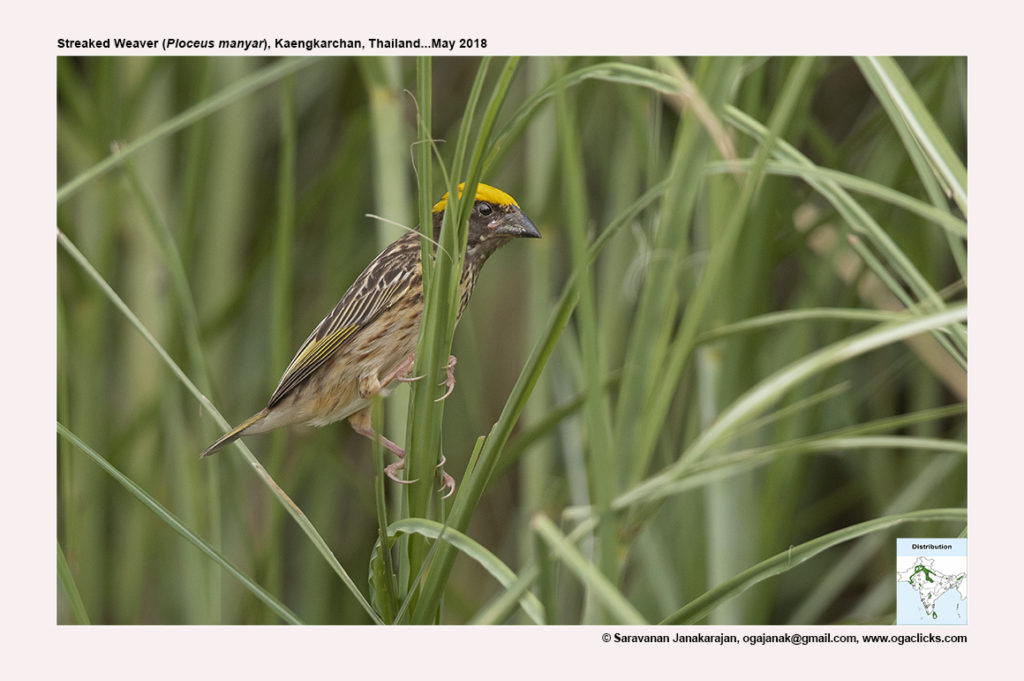
Streaked Weaver Ploceus manyar
Etymology:
- Ploceus : Greek word plokeus – weaver, braider, plaiter derived from pleko – to plait, to entwine
- Manyar: Tamil name Manja for various weavers
Vernacular Names: Hindi: Bamani baya, Telia baya, Pun: Dharidar bijra, Ben: Telia baya, Tite-babui, Tal chata, B’ desh: Bawayi, Guj: Lintivali/ Rekhankith/ Rekhavala sugari, Ta: Thukanan kuruvi, Manja kuruvi, Te: Charala pichuka, Mal: Attakkuruvi, Kayatatta, Sinh: Wadu kurulla, Mar: Reshal Sugaran
Distribution in India: Wide spread resident of North and sporadic through other places in India.
Description: Size of 15 cm; wt. of 16–22 g. The male of nominate race in breeding plumage has forehead and crown as golden-yellow, sharply demarcated from blackish-brown lores, cheek, ear-coverts, chin and throat; nape to back feathers are brown with rusty-coloured edges, rump feathers are rust-brown with narrow central streaks; tail and upperwing are dark brown, remiges are with yellow margins, wing-coverts are with pale edges; breast and belly are creamy white in center, sides and flanks are rust-coloured, dark brown streaking throughout; thighs are buffy with dark streaking, undertail-coverts are creamy white; iris is dark brown; bill is black; legs are pinkish-flesh. The male in non-breeding plumage loses most of yellow on crown, has supercilium as yellow, cheek is brown, chin and throat are yellowish but streaked; bill is pinkish-horn. The female breeding plumage is similar to non-breeding male but less boldly patterned: crown and nape are dull brown with dusky streaks; supercilium and patch on side of neck is yellow, lores and ear-coverts are greyish lightly streaked with dusky brown, short darker dusky brown moustachial stripe enhanced by pale yellowish crescent beneath eye and by similarly coloured submoustachial area; chin and throat are pale yellowish buff, separated from submoustachial area by dusky-brown stripe; bill is horn-colour to fleshy-orange; legs are pinkish-flesh. The female non-breeding has forehead and crown dark brown, prominent yellow supercilium; yellow fleck below grey-brown ear-coverts; chin and throat are creamy white. The juvenile resembles non-breeding female, but with buffy wash over plumage, less heavily streaked, yellow-brown bill. The races differ mainly in details of male breeding plumage: race flaviceps has face mask and streaking black, rather than brown, crown is paler yellow, ground colour of breast and flanks are paler; race peguensis has very heavy black streaking, breast and flanks intermediate in colour between nominate and previous; race williamsoni also is intermediate in coloration, with side of head and streaking brown, rather than black.
Habitat: It is found in wetlands, reedbeds and rice paddies, often with bulrushes and associated especially with elephant grass.
Food Habits: It eats seeds, including those of the grasses, rice, wheat, millet and sorghum. The young are fed chiefly with animal food, mainly insects, with grasshoppers, caterpillars, beetles, spiders and small snails. It forages in flocks, often with other Weavers. It forms daytime roosts near feeding grounds in hottest months. In non-breeding season, communal roosts are formed in reedbeds and sugar cane.
Breeding Habits: They Breed in Jun–Sept in Pakistan and India, Feb–Apr and Jul–Oct in Sri Lanka, Jun–Oct in Myanmar and Mar–May in Java. Flight displays over territory accompanied by song. The nest is retort-shaped, woven on to leaves of supporting plants, sometimes with entrance tunnel, entrance facing downwards, woven by male from strips of reed or palm leaves, female assists later and adds lining of fine grass stems .The nest is placed up above water surface in reeds and bulrushes, or in elephant grass, sometimes in palm or on mangrove close to human habitation, and in some areas suspended from vegetation growing out of sides of irrigation wells; small lumps of mud or clay applied to sides of entrance of many nests, perhaps to anchor loose ends of material, and yellow flowers sometimes affixed to mud blobs or wet buffalo dung, or placed elsewhere on nest. They lay clutch of 2–3 eggs. The incubation is shared by male initially, and then done by female alone. The incubation period is 14–17 days. The chicks are fed by both sexes, male contributing once nestlings are 10 days old. The nestling period is 17–18 days. Snakes and crows are significant nest predators, and changeable lizard prey on eggs. In the reedbeds, many nests destroyed by grazing cattle and by people harvesting reeds.